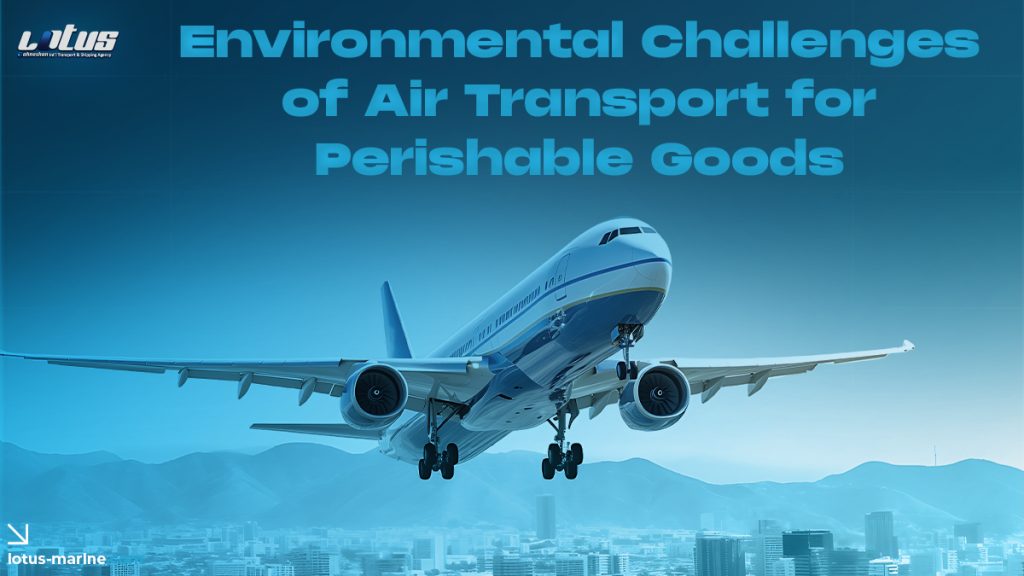Introduction
The global movement of perishable goods, such as fresh produce, seafood, and pharmaceuticals, heavily relies on air transport. While this mode of transportation ensures speed and efficiency, it also presents significant environmental challenges. Addressing these challenges is critical for creating a sustainable future for perishable logistics.
Understanding Perishable Goods in Air Transport
Perishable goods are products that have a short shelf life and require precise environmental conditions to maintain their quality. Examples include fruits, vegetables, dairy products, and vaccines. Air transport is the preferred mode due to its ability to deliver goods quickly, reducing the risk of spoilage.
The Role of Air Transport in Global Perishable Supply Chains
Air transport plays a vital role in the global supply chain of perishables, enabling producers to reach international markets. The speed and efficiency of air freight contribute significantly to economic growth and global trade. However, this comes at an environmental cost.
Key Environmental Challenges in Air Transport
High Carbon Emissions
Air freight is one of the most carbon-intensive modes of transport. The high fuel consumption required for perishable goods, often transported in temperature-controlled environments, exacerbates emissions.
Fuel Consumption and Efficiency
Aircraft used for perishable goods often consume more fuel due to the additional weight of refrigeration units and packaging materials.
Noise Pollution
Noise generated by aircraft during takeoff and landing affects nearby communities and ecosystems.
Impact of Temperature Control on Energy Use
Maintaining the cold chain during transport is energy-intensive. Refrigerated containers, or Unit Load Devices (ULDs), require significant power to keep perishables at the required temperatures. This raises concerns about energy efficiency and environmental impact.
Packaging Waste in Perishable Air Transport
Single-Use Plastics
Perishable goods often require extensive packaging to ensure safety and quality. However, single-use plastics and non-biodegradable materials contribute to environmental degradation.
Sustainable Alternatives
Biodegradable and reusable packaging solutions are emerging, offering a balance between protecting goods and reducing waste.
Cold Chain Logistics and Environmental Concerns
Cold chain logistics rely on non-renewable energy sources, adding to carbon emissions. Transitioning to renewable energy solutions, such as solar-powered refrigeration, is a critical step toward sustainability.
Regulatory Frameworks and Compliance
International organizations like the International Air Transport Association (IATA) have introduced guidelines to reduce environmental impacts. Compliance with these standards ensures responsible practices but requires significant investment from stakeholders.
Adopting Green Technologies in Air Transport
Electrification of Ground Operations
Airports and logistics companies are increasingly electrifying ground support equipment, reducing reliance on fossil fuels.
Sustainable Aviation Fuels (SAFs)
SAFs, derived from renewable sources, offer a promising alternative to traditional jet fuel, significantly lowering carbon footprints.
Carbon Offsetting in the Air Freight Industry
Carbon offset programs enable companies to compensate for their emissions by investing in environmental projects. Successful initiatives, such as reforestation and renewable energy projects, highlight the potential of offsetting.
Role of IoT and AI in Reducing Environmental Impact
IoT devices and AI-driven analytics allow for real-time monitoring of perishable shipments. By optimizing routes and improving efficiency, these technologies reduce waste and energy consumption.
Case Studies of Sustainable Practices
Airlines Adopting Green Technologies
Major airlines have begun integrating SAFs and investing in energy-efficient fleets to minimize environmental impact.
Logistics Providers Reducing Waste
Innovative packaging solutions and renewable energy integration have helped logistics providers achieve sustainability goals.
Challenges in Implementing Sustainable Air Freight
Cost Barriers
Green technologies and sustainable practices often come with high upfront costs, deterring widespread adoption.
Technology Gaps
The lack of infrastructure and technical expertise in certain regions slows progress toward sustainability.
Future Trends in Sustainable Perishable Air Transport
The future of air freight lies in innovation. Electrification of short-haul flights and advancements in bio-based packaging materials promise a more sustainable industry.
Conclusion
The environmental challenges of air transport for perishable goods demand immediate attention. By embracing green technologies, improving energy efficiency, and collaborating across the supply chain, the industry can move toward a sustainable future.
FAQs
Q1: What are the main environmental challenges in air transport for perishable goods?
A1: High carbon emissions, energy-intensive refrigeration, and packaging waste are key challenges.
Q2: How can sustainable aviation fuels help?
A2: SAFs reduce the carbon footprint of air freight by using renewable sources instead of traditional jet fuels.
Q3: What role does IoT play in reducing environmental impact?
A3: IoT enables real-time monitoring and optimization of logistics, reducing waste and energy consumption.
Q4: Why is packaging waste a concern in perishable transport?
A4: Extensive use of single-use plastics contributes to environmental degradation, necessitating sustainable alternatives.
Q5: What are future trends in sustainable air freight?
A5: Trends include electrification of flights, bio-based packaging, and enhanced cold chain solutions.







